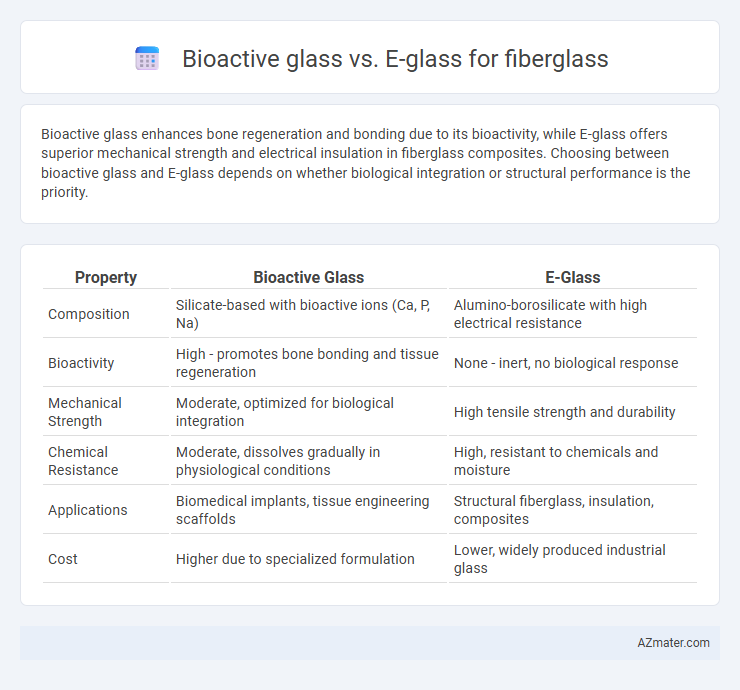Bioactive glass enhances bone regeneration and bonding due to its bioactivity, while E-glass offers superior mechanical strength and electrical insulation in fiberglass composites. Choosing between bioactive glass and E-glass depends on whether biological integration or structural performance is the priority.
Table of Comparison
| Property | Bioactive Glass | E-Glass |
|---|---|---|
| Composition | Silicate-based with bioactive ions (Ca, P, Na) | Alumino-borosilicate with high electrical resistance |
| Bioactivity | High - promotes bone bonding and tissue regeneration | None - inert, no biological response |
| Mechanical Strength | Moderate, optimized for biological integration | High tensile strength and durability |
| Chemical Resistance | Moderate, dissolves gradually in physiological conditions | High, resistant to chemicals and moisture |
| Applications | Biomedical implants, tissue engineering scaffolds | Structural fiberglass, insulation, composites |
| Cost | Higher due to specialized formulation | Lower, widely produced industrial glass |
Introduction to Bioactive Glass and E-glass
Bioactive glass is a specialized type of glass known for its ability to bond with bone tissue, making it highly valued in biomedical applications such as bone regeneration and dental implants. E-glass, or electrical glass, is a common fiberglass composition primarily composed of silica, alumina, calcium oxide, and boron oxide, designed for its excellent electrical insulation and mechanical strength properties. While bioactive glass enhances biological integration, E-glass is widely used in structural and electrical applications due to its durability and cost-effectiveness.
Chemical Composition of Bioactive Glass and E-glass
Bioactive glass typically consists of silica (SiO2), calcium oxide (CaO), sodium oxide (Na2O), and phosphorus pentoxide (P2O5), designed to interact with biological systems and promote bone bonding. E-glass is primarily composed of silica (SiO2), alumina (Al2O3), calcium oxide (CaO), and boron oxide (B2O3), optimized for electrical insulation and mechanical strength in fiberglass applications. The presence of phosphorus pentoxide in bioactive glass distinguishes its bioactivity, while E-glass's alumina and boron content provide enhanced durability and performance for structural uses.
Mechanical Properties Comparison
Bioactive glass exhibits superior bioactivity and bond strength with bone tissue compared to E-glass, enhancing osteointegration in biomedical applications, while E-glass offers higher tensile strength and stiffness, making it ideal for structural fiberglass composites. The mechanical properties of bioactive glass fibers typically include lower tensile strength (around 1.6 GPa) and elastic modulus (35-40 GPa) than E-glass fibers, which have tensile strengths up to 3.4 GPa and elastic modulus between 70-85 GPa. This trade-off influences the selection of glass type based on the desired balance between bioactivity and mechanical performance in fiberglass materials.
Bioactivity and Biocompatibility
Bioactive glass exhibits superior bioactivity compared to E-glass, enabling it to bond chemically with bone tissue through the formation of a hydroxycarbonate apatite layer, which enhances tissue integration and regeneration. E-glass, while mechanically strong and cost-effective for composite materials, lacks inherent bioactivity and does not promote cell attachment or osteointegration, limiting its use in biomedical applications. Bioactive glass ensures excellent biocompatibility with minimal inflammatory response, making it ideal for implants and tissue engineering, whereas E-glass primarily serves structural purposes without significant biological interaction.
Applications in Biomedical Engineering
Bioactive glass and E-glass serve distinct roles in biomedical engineering, with bioactive glass primarily used for bone regeneration and tissue scaffolding due to its ability to bond with bone and stimulate osteogenesis. E-glass, characterized by its high strength and electrical insulation properties, is commonly employed in medical devices and prosthetics where structural support and durability are critical. The bioactivity of bioactive glass enables enhanced integration with biological tissues, whereas E-glass provides mechanical reinforcement without promoting biological interactions.
Durability and Corrosion Resistance
Bioactive glass exhibits superior corrosion resistance compared to E-glass due to its ability to form a stable hydroxycarbonate apatite layer that protects the material surface in harsh environments. E-glass fibers, while durable and widely used in fiberglass composites, are more susceptible to alkaline-induced degradation and moisture attack, leading to reduced long-term durability. The enhanced corrosion resistance of bioactive glass makes it ideal for biomedical and marine applications where prolonged exposure to corrosive agents is a critical factor.
Optical and Thermal Properties
Bioactive glass exhibits superior optical transparency and a higher refractive index compared to conventional E-glass, making it more suitable for applications requiring enhanced light transmission and precise optical performance. Thermal conductivity of bioactive glass is generally lower, providing better insulation and thermal stability under fluctuating temperatures, whereas E-glass offers higher thermal resistance and mechanical strength but with reduced optical clarity. The choice between bioactive glass and E-glass for fiberglass applications depends on prioritizing either advanced optical functionality or robust thermal endurance.
Manufacturing Processes and Costs
Bioactive glass fibers require specialized melting and drawing processes at higher temperatures compared to E-glass, resulting in increased manufacturing complexity and costs. E-glass, produced through well-established float and continuous filament methods, benefits from lower raw material expenses and streamlined production. The enhanced bioactivity of bioactive glass justifies its premium cost in medical applications, whereas E-glass remains the cost-effective choice for general fiberglass composites.
Environmental Impact and Sustainability
Bioactive glass offers superior environmental benefits compared to traditional E-glass due to its ability to bond with biological tissues and promote tissue regeneration, reducing the need for frequent replacements in medical and dental applications. E-glass production relies heavily on energy-intensive processes and raw materials like silica sand and alumina, generating significant greenhouse gas emissions and non-biodegradable waste. Bioactive glass materials are increasingly favored for sustainable fiberglass solutions as they enable lower lifecycle environmental footprints through recyclability and bio-compatibility in industrial and biomedical uses.
Future Developments and Market Trends
Bioactive glass is gaining traction in the fiberglass market due to its superior biocompatibility and potential in medical and environmental applications, surpassing traditional E-glass in specialized niches. Future developments focus on enhancing bioactivity and mechanical properties through nanoscale engineering and hybrid composite formulations, aiming to expand its use in tissue engineering and sustainable construction. Market trends indicate a growing demand for eco-friendly and multifunctional fiberglass materials, driving innovation and investment towards bioactive glass-based products with improved performance and reduced environmental impact.

Infographic: Bioactive glass vs E-glass for Fiberglass
 azmater.com
azmater.com